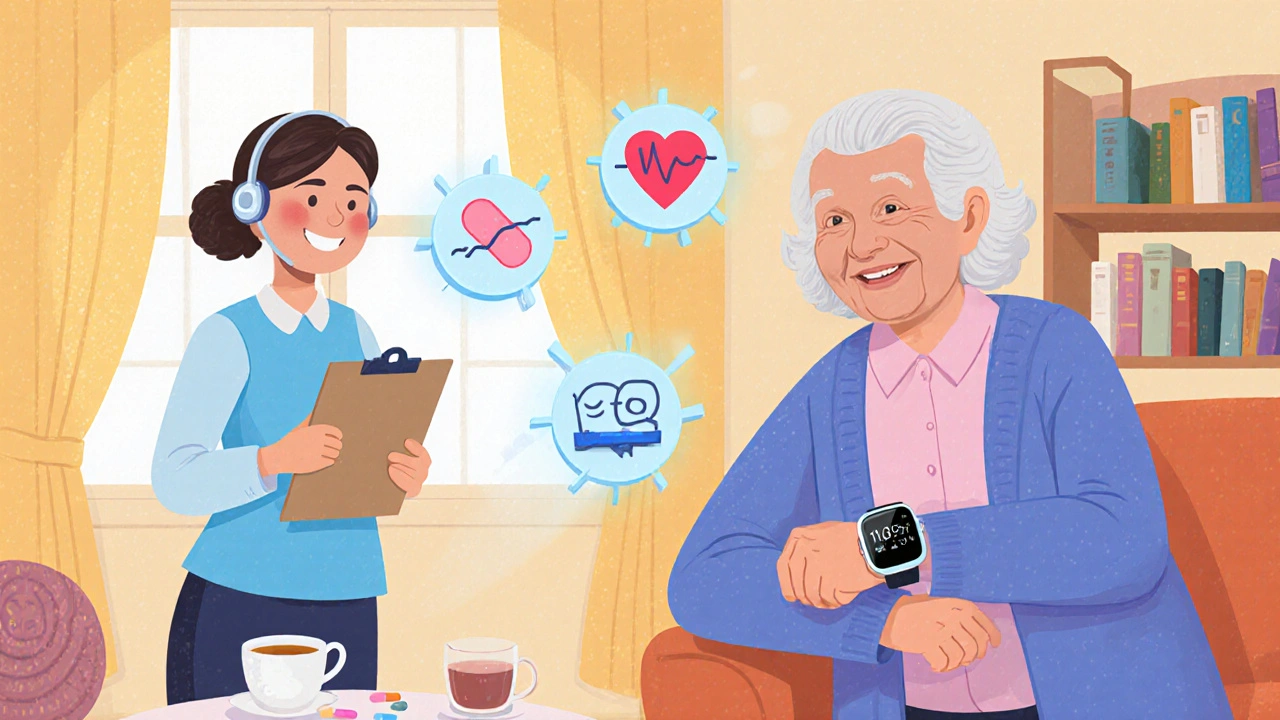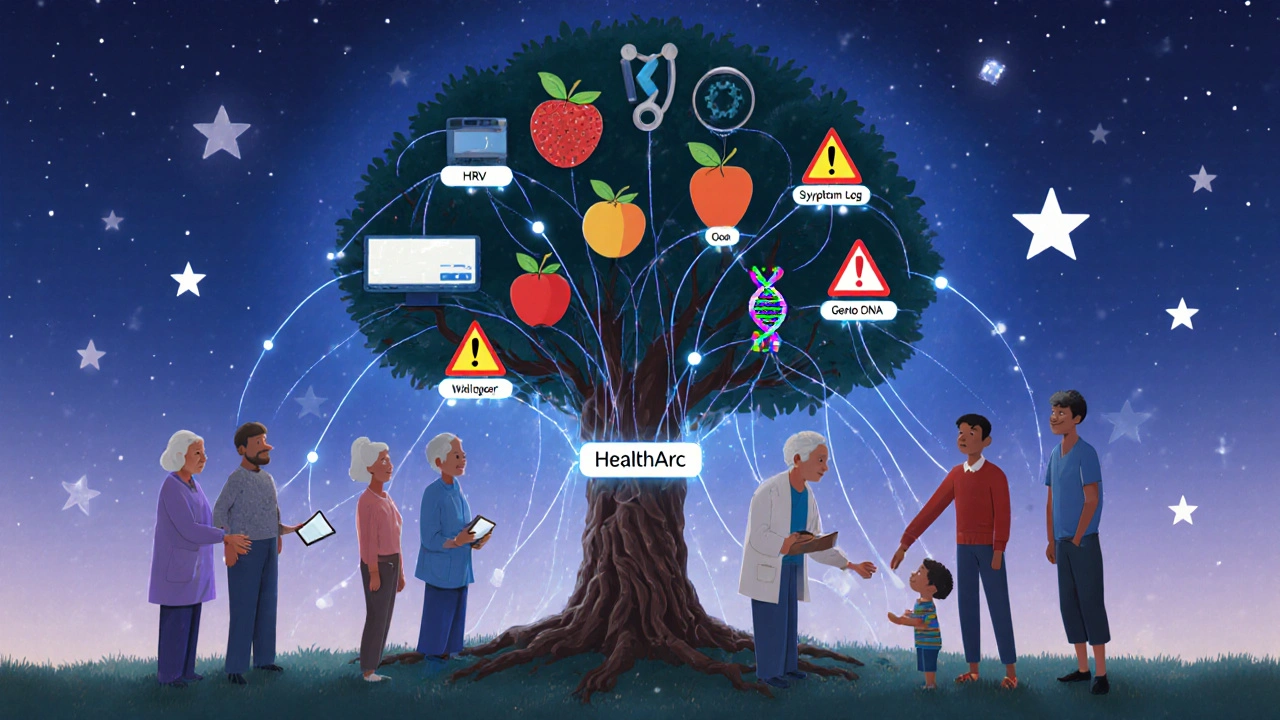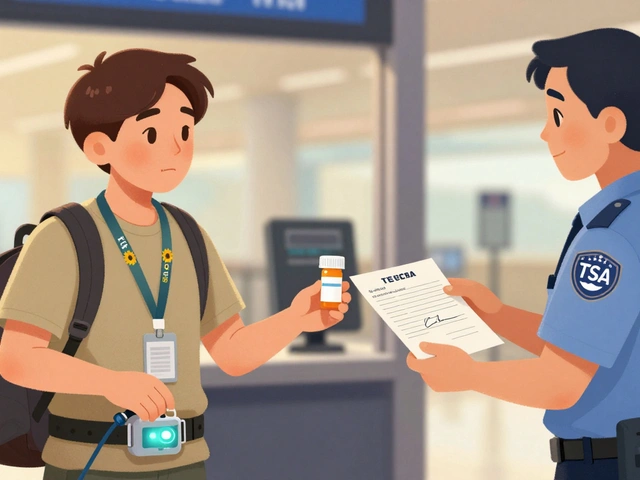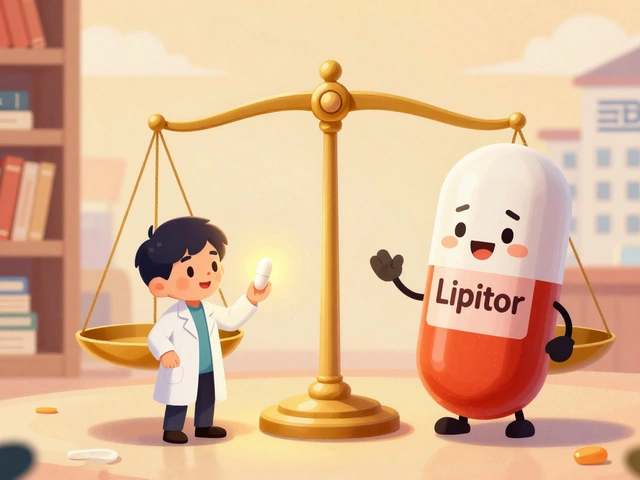
Medication Side Effect Monitoring Platform Selector
Select your medication type and other factors to find the best platform for monitoring medication side effects.
Every year, over 1.3 million Americans are hospitalized because of unexpected reactions to their medications. Many of these reactions don’t show up until it’s too late - a sudden drop in blood pressure, an irregular heartbeat, or confusion that gets written off as aging. What if you could catch these signs before they turn into emergencies? That’s exactly what remote monitoring for medication side effects is designed to do. And in 2025, the tools are more accurate, more connected, and more accessible than ever.
How These Systems Actually Detect Side Effects
It’s not just about remembering to take your pills. Modern systems watch your body while you take them. Think of it like a silent health assistant that never sleeps. Devices like the Apple Watch Series 9 or Fitbit Charge 6 track your heart rate variability (HRV), sleep patterns, and movement. Apps like Medisafe and AiCure combine that data with your medication schedule. If your HRV drops more than 15% from your normal baseline for two full days after starting a new blood pressure drug, the system flags it. That’s not guesswork - it’s based on clinical studies from Massachusetts General Hospital.
Some platforms go further. AiCure uses your smartphone camera to watch your face. It doesn’t just confirm you swallowed the pill - it looks for subtle signs like drooping eyelids, slow blinking, or unsteady head movements. These are classic signs of dizziness or sedation from psychiatric or pain medications. Their AI detects these patterns with 96.7% accuracy, according to their March 2025 white paper. For patients on antipsychotics or opioids, that’s life-changing.
Then there’s Mango Health, which reads what you type. If you log “I feel foggy” or “My hands are shaking,” it compares your words to over 1.2 million documented side effects from the FDA’s Adverse Event Reporting System. It spots connections you might miss - like how a new antidepressant could be causing tremors that look like Parkinson’s. Their system gets it right 89.3% of the time, based on peer-reviewed research in the Journal of Medical Internet Research.
Top Platforms Compared: What Works Best for You
Not all apps are built the same. Here’s how the leading players stack up in 2025:
| Platform | Side Effect Detection Method | Device Integration | Cost (Annual per Patient) | Best For |
|---|---|---|---|---|
| AiCure | AI facial analysis + medication verification | Smartphone only | $249 | Clinical trials, high-risk patients |
| Medisafe | HRV, sleep, activity + symptom logs | 78 wearables (Apple Watch, Fitbit, etc.) | $99 | Chronic disease patients, seniors |
| Mango Health | NLP analysis of symptom reports | Basic smartphone sensors | $75 | Psychiatric meds, patients who track symptoms |
| HealthArc | Adaptive Side Effect Detection Engine (ASDE) | 42 medical devices | $150+ (enterprise only) | Hospitals, large clinics |
| Pill Identifier & Med Scanner | Pill recognition only | None | Free | Verifying pills, not monitoring effects |
AiCure is the most precise, but it’s expensive and meant for research settings. Medisafe strikes the best balance for everyday use - it’s affordable, integrates with popular wearables, and works with most EHR systems like Epic. If you’re on multiple psychiatric meds and notice mood or cognitive shifts, Mango Health’s text-based analysis might catch things your wearable misses. HealthArc is powerful but only makes sense for clinics managing dozens of patients. And don’t be fooled by pill scanner apps - they only tell you what the pill is, not how your body is reacting to it.
The Real-World Impact: Less Hospital Visits, More Peace of Mind
At Mayo Clinic, heart failure patients using remote monitoring saw severe adverse drug events drop by 37%. Why? Because their systems caught electrolyte imbalances from diuretics before they caused dangerous heart rhythms. That’s not theory - it’s real data from over 1,200 patients tracked over 18 months.
For caregivers, the relief is immediate. Platforms like mySeniorCareHub, launched in early 2025, let family members see if an elderly parent’s medication is causing dizziness or confusion. One user wrote: “I used to panic every time my mom skipped a meal. Now the app tells me it’s likely her new blood thinner, not a stroke.” That’s the kind of insight that keeps people out of the ER.
But it’s not perfect. The biggest complaint? False alarms. Mango Health users report being nagged by alerts for normal fatigue. One Reddit user said the app flagged his tiredness as a side effect of his antidepressant - even though he’d been on it for six months. That kind of “alert fatigue” is real. A survey by the American Medical Association found 68% of providers have turned off some alerts because they’re too noisy. That’s dangerous - if you ignore too many, you might miss the one that matters.

Who Benefits Most - And Who’s Left Behind
These tools work best for people on high-risk medications: blood thinners, diabetes drugs, heart medications, antidepressants, or opioids. They’re also ideal for older adults managing five or more pills a day. But not everyone benefits equally.
Early data from the Centers for Medicare & Medicaid Services shows side effect detection algorithms are 23% less likely to flag problems in elderly African American patients. Why? Because the AI was trained mostly on data from younger, white populations. The FDA now requires all new systems to test across age, gender, and racial groups - a rule that went into effect in February 2025. But legacy systems still have gaps.
Another issue? Access. If you don’t have a smartphone, a reliable internet connection, or the tech skills to set up a wearable, these tools won’t help you. That’s why companies like Medtronic now offer cellular-enabled devices that don’t need Wi-Fi. Their CareLink system maintains 99.2% uptime - crucial for patients in rural areas or with limited mobility.
What’s Coming Next: AI, Genetics, and Smarter Alerts
The next wave is even more powerful. AiCure is testing “Digital Twin” technology - a digital copy of your body that simulates how you’ll react to a new drug before you even take it. In trials, it improved side effect prediction by 43%. Imagine knowing your body will hate a certain statin before your doctor prescribes it.
At the same time, Mayo Clinic’s RIGHT Study is combining remote monitoring with genetic testing. They found that 67% of adverse drug events in genetically vulnerable patients could be avoided by adjusting meds before they started. That’s the future: personalized medicine powered by your DNA and your daily vitals.
The FDA is also tightening rules. Their April 2025 draft guidance will require all AI-based side effect tools to prove they reduce false alarms by 30-40%. That means fewer useless alerts - and more trust in the ones that come through.

Getting Started: What You Need to Do Now
If you’re considering one of these systems, here’s how to begin:
- Check with your doctor or pharmacist - ask if they use or recommend any remote monitoring tools.
- Make sure your smartphone runs iOS 15 or Android 10 or higher. Older devices won’t run the AI properly.
- Choose a platform that matches your needs: wearables? Go with Medisafe. Symptom journaling? Try Mango Health.
- Set up your device and link it to your EHR if possible. Integration with Epic or Cerner means your care team sees the alerts too.
- Don’t ignore false alerts - but don’t panic. Log them. Patterns matter more than single warnings.
Successful programs, like Geisinger Health’s, assign a “digital health navigator” to each patient. That person walks you through setup, answers questions, and helps you interpret alerts. Ask if your clinic offers something similar. Patient engagement jumps from 63% to 89% with that kind of support.
Privacy and the Big Risk Nobody Talks About
These apps collect deeply personal data: your heartbeat, your mood logs, your pill-taking habits. Right now, HIPAA protects this data - but only if your provider uses a certified system. Many consumer apps don’t.
Worse, insurers could use this data to deny coverage. A 2025 KLAS Research survey found 72% of patients fear their side effect history could be used against them. That’s why experts like Dr. Elena Rodriguez warn that current laws aren’t enough. Always check a platform’s privacy policy. Look for terms like “HIPAA-compliant,” “encrypted,” and “no third-party sharing.”
And remember - these tools are assistants, not replacements. If you feel something’s wrong, call your doctor. The app can warn you. But only you can decide when it’s serious enough to act.
Can remote monitoring apps really prevent hospital visits?
Yes. Studies show AI-powered systems can reduce severe adverse drug events by up to 37% in high-risk populations like heart failure patients. By catching early signs like abnormal heart rhythms or electrolyte shifts, these tools help doctors adjust medications before hospitalization becomes necessary. The Deloitte 2024 report estimates this technology could prevent 1.2 million hospitalizations annually by 2027.
Are these apps covered by insurance?
In 2025, Medicare and many private insurers now reimburse for Remote Therapeutic Monitoring (RTM) codes that include medication side effect tracking. Patients can qualify for $52-$67 per month in reimbursement if their provider uses a certified platform and meets documentation requirements. Always confirm coverage with your insurer and provider before signing up.
Do I need a smartwatch to use these apps?
No, but it helps. Apps like Medisafe and Mango Health work with just a smartphone. But if you want to monitor heart rate variability, sleep quality, or activity levels, a compatible wearable like an Apple Watch or Fitbit adds critical data. Without it, the system relies only on self-reported symptoms, which are less reliable.
What if the app gives me too many false alerts?
Alert fatigue is a real problem. Many users report being overwhelmed by notifications. The key is to work with your care team to adjust alert thresholds. Some platforms let you customize sensitivity levels. If alerts are too frequent, ask if your provider can fine-tune the system or disable low-risk triggers. Never ignore all alerts - but don’t panic over every one either.
Can these systems detect side effects from herbal supplements or over-the-counter meds?
Yes - if you log them. Most platforms only monitor prescription drugs unless you manually enter OTC meds or supplements. Mango Health and Medisafe let you add anything you take. The system then cross-references your entries with known interactions. If you take turmeric with blood thinners or St. John’s Wort with antidepressants, logging those is essential for accurate alerts.
Are these apps safe for elderly patients?
They can be, but setup matters. Simpler interfaces like Medisafe and mySeniorCareHub are designed for older users. Cellular-enabled devices like Medtronic’s CareLink help when Wi-Fi is unreliable. The biggest challenge isn’t the tech - it’s the learning curve. Many clinics now assign digital health navigators to help seniors get started. Look for programs that offer in-person or video setup support.
Remote monitoring for medication side effects isn’t science fiction anymore. It’s here - and it’s saving lives. The technology isn’t flawless, but it’s getting better every year. The key is using it wisely: choose the right tool, pair it with your care team, and never let alerts replace your own instincts. Your body is still the best detector you’ve got.







Katy Bell
November 22, 2025 AT 22:57I used Mango Health for my mom’s antidepressant last year - it flagged her tremors before her doctor even noticed. She thought it was just aging, but the app said ‘possible SSRI-induced dyskinesia’ and we got her med switched. Saved her from a fall and a hospital trip. I cried when I saw that alert. Not because I was scared - because for once, tech actually got it right.
Also, it’s wild how it learns your baseline. After two weeks, it stopped nagging her about ‘low energy’ on rainy days. That’s intelligence. Not just algorithms.
Still… I wish it could track herbal stuff better. She takes ashwagandha for sleep and it ignored it. Big miss.
Ragini Sharma
November 23, 2025 AT 07:32so like… i tried medisafe n my phone died after 2 days of alerts lmao
also it kept telling me i was ‘dehydrated’ bc i drank 2 coffees n skipped water for 8 hrs?? like sis i’m a grad student not a lab rat
but tbh the facial thing with aicure? creepy as hell. my roommate saw me staring at my phone like a zombie trying to swallow a pill and asked if i was possessed. i said ‘no, just being monitored’ and she ran out of the room.
also why is it $249?? i could buy a whole new phone for that. #ripmywallet
Linda Rosie
November 24, 2025 AT 04:58Effective monitoring reduces adverse events. Clinical validation exists. Implementation requires interoperability. Cost-benefit analysis favors adoption in high-risk cohorts. Privacy compliance remains non-negotiable. Data equity must be prioritized in algorithmic training. Patient autonomy must not be compromised by automation. These systems augment, not replace, clinical judgment.
Recommendation: Use only HIPAA-compliant, FDA-cleared platforms.
Vivian C Martinez
November 25, 2025 AT 19:47If you’re on meds and worried about side effects, don’t wait until you’re dizzy or confused to act. Start small - even just logging your symptoms in Mango Health for a week gives you data your doctor will actually listen to. I helped my dad set it up last month. He didn’t believe it would work… until it caught his blood pressure dropping after a new beta-blocker. Now he checks it every morning like a ritual. No more panic calls at 3 a.m. That’s peace of mind you can’t buy.
And yes, the alerts can be annoying - but tweak the settings. Talk to your pharmacist. You’re not stuck with the default. You’ve got control.
Ross Ruprecht
November 26, 2025 AT 00:31Ugh. Another tech bro article pretending wearables are magic. My grandma can’t even turn on her TV without calling me. You think she’s gonna set up an AI that watches her face while she swallows a pill? Nah. This is just Silicon Valley selling solutions to problems rich people invented.
Also, $249 for facial recognition? I’ll take my chances with my own eyes and a phone call to the doctor. Free. Human. Real.
Bryson Carroll
November 26, 2025 AT 22:51Let’s be real - this is just surveillance with a wellness veneer. You’re being watched while you swallow your pills. Your heartbeat is being logged. Your mood is being parsed by some algorithm trained on data from people who don’t look like you. And you think this is ‘saving lives’?
Meanwhile, the FDA just mandated diversity in training data - but the companies already sold millions of these apps. The damage is done. Your grandmother’s tremors were ignored because her skin tone didn’t match the training set. And now you’re supposed to be grateful?
Also, why is everyone acting like this is new? We had pill reminder apps in 2012. This is just AI-washing. And the cost? Absurd. You’re paying for a fancy alarm clock with a camera.
And don’t even get me started on ‘digital twins’ - that’s not medicine, that’s sci-fi fanfiction. Wake up. This isn’t progress. It’s profit.
Lisa Lee
November 28, 2025 AT 22:46Why are we letting American tech companies dictate how Canadians manage their health? We have universal healthcare - we don’t need to buy apps to monitor side effects. This is just corporate exploitation wrapped in ‘innovation.’
And why is everyone praising Apple Watch? We don’t need another gadget. We need better drug safety laws, not more surveillance. This isn’t progress - it’s capitalism pretending to care.
Jennifer Shannon
November 29, 2025 AT 23:27You know, I think about this stuff a lot - not just as a patient, but as a person who’s watched my father navigate five different meds for Parkinson’s, diabetes, and hypertension. There’s something deeply human about the fear of not knowing whether your body’s betraying you - and how desperately we want something, anything, to whisper, ‘It’s okay, you’re not crazy.’
These apps? They’re not perfect. They’re clunky. They over-alert. They miss things. But they’re also the first time, in my lifetime, that technology has tried to listen to the quiet, invisible symptoms - the foggy mornings, the shaky hands, the ‘I just feel off’ - that doctors often dismiss as ‘just aging’ or ‘stress.’
And yes, the racial bias in the algorithms? That’s a tragedy. And it’s not just a technical flaw - it’s a moral one. We built these tools with data from people who look like us, and then we expected them to work for everyone. That’s arrogance dressed as innovation.
But here’s the thing: the fact that we’re even having this conversation means we’re getting closer. We’re starting to ask the right questions: Who is this for? Who’s being left out? Who’s paying? Who’s listening?
And maybe, just maybe, if we keep asking, the next version won’t just detect side effects - it’ll detect dignity.
Also, I just logged ‘felt tearful after taking sertraline’ in Mango Health. It didn’t flag it. But I did. And that’s enough for now.
Suzan Wanjiru
November 30, 2025 AT 16:34For real - if you’re on antipsychotics or opioids, Mango Health is a game changer. I’m a nurse and I’ve seen patients miss tremors or slurred speech because they’re too embarrassed to say it out loud. The app lets them type it anonymously. That’s huge.
Also, don’t sleep on the free pill scanner app - it’s useless for side effects but if you’re mixing meds and don’t know what’s in that pill you found in the cabinet? It saved my cousin from accidentally taking her dad’s old morphine.
Just make sure you’re on iOS 15 or Android 10. Older phones crash the AI. And turn off notifications after midnight. Sleep is sacred.
Kezia Katherine Lewis
December 1, 2025 AT 00:12From a clinical informatics standpoint, the integration of multimodal biometric telemetry (HRV, actigraphy, facial micro-movements) with NLP-driven symptom lexicons represents a paradigm shift in pharmacovigilance. The ASDE engine in HealthArc, in particular, demonstrates superior sensitivity in detecting subclinical autonomic dysregulation, particularly in polypharmacy cohorts.
That said, the current regulatory landscape remains fragmented. While RTM reimbursement codes (CPT 99453–99454) are now codified under CMS, interoperability with EHRs remains inconsistent, particularly with non-certified Cerner and Epic interfaces. Furthermore, algorithmic bias mitigation requires continuous retraining on ethnically stratified datasets - a process that is neither standardized nor mandated in post-market surveillance.
Recommendation: Prioritize platforms with FDA De Novo classification and SOC 2 Type II certification. Avoid consumer-grade apps without explicit HIPAA Business Associate Agreement (BAA) execution.